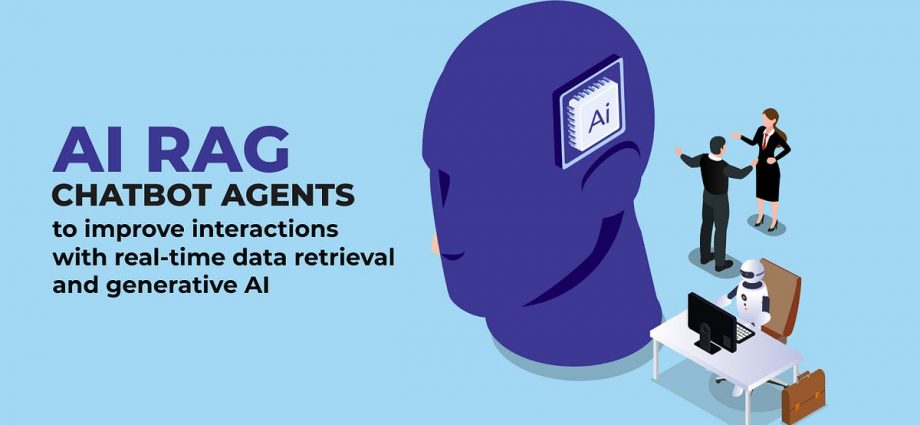Artificial Intelligence (AI) has transformed the way businesses and individuals interact through chatbots. However, traditional chatbot models often struggle with retrieving accurate information and providing contextually relevant responses. AI RAG Chatbot Agents, powered by Retrieval-Augmented Generation (RAG), bridge this gap by integrating real-time information retrieval with generative AI capabilities. This article explores how to Build AI RAG Chatbot Agents and leverage AI RAG Chatbot Agent Development for smarter, more interactive conversations.
What is an AI RAG Chatbot Agent?
An AI RAG Chatbot Agent is an advanced chatbot system that combines retrieval-based and generative AI models to deliver more accurate, informative, and contextually aware responses. Unlike traditional chatbots, which rely solely on pre-trained models or predefined responses, RAG chatbots retrieve real-time data from external sources before generating responses, making them more intelligent and dynamic.
Why Use AI RAG Chatbot Agents?
Enhanced Accuracy: RAG chatbots pull data from trusted sources, reducing misinformation.
Context Awareness: They understand user queries in depth and provide contextually relevant answers.
Scalability: Ideal for customer support, knowledge bases, and interactive assistants.
Real-Time Updates: Can fetch the latest data from APIs, databases, or documents.
Key Components of AI RAG Chatbot Agent Development
To successfully develop AI RAG Chatbot Agents, you need to integrate several components:
1. Natural Language Processing (NLP) Model
The core of any chatbot is its ability to understand and generate human-like responses. Popular NLP models include:
★OpenAI’s GPT-4
★Google’s PaLM
★Meta’s Llama
★Hugging Face Transformers
2. Retrieval System
A retrieval engine fetches relevant documents, FAQs, or structured/unstructured data from various sources. This can be implemented using:
★Elasticsearch
★FAISS (Facebook AI Similarity Search)
★LangChain for document retrieval
3. Data Source Integration
AI RAG chatbots require access to external and internal knowledge bases. These may include:
★APIs for real-time data fetching
★Databases (MySQL, PostgreSQL, MongoDB)
★Company documents, PDFs, and FAQs
4. Response Generation (Generative AI Layer)
After retrieving relevant data, the chatbot uses a generative model to craft responses. This can be achieved using:
★Transformer-based models
★Fine-tuned LLMs (Large Language Models)
5. Memory and Context Management
To ensure seamless conversations, chatbots must retain context across multiple interactions. This is done using:
★Vector databases (Pinecone, Weaviate)
★Session-based memory systems
6. User Interface and Interaction
To provide a smooth user experience, AI RAG chatbots should be integrated into:
★Web-based chat interfaces (Chat widgets, custom dashboards)
★Mobile applications (iOS, Android integration)
★Voice assistants (Amazon Alexa, Google Assistant)
Steps to Build AI RAG Chatbot Agents
Step 1: Define Use Case and Requirements
Before you start, outline the specific needs of your chatbot:
★Is it for customer support, e-commerce, or healthcare?
★What type of knowledge sources will it use?
★Does it require real-time data retrieval?
Step 2: Choose a Suitable AI Model
Select an AI language model based on your chatbot’s complexity:
★Small-scale models: GPT-3.5, BERT (for simple queries)
★Advanced models: GPT-4, Claude AI (for complex conversations)
Step 3: Set Up a Retrieval System
Implement an information retrieval mechanism:
★Use Elasticsearch to index and fetch relevant content.
★Integrate LangChain for improved document retrieval.
Step 4: Connect Data Sources
★API integration for real-time responses.
★Connect the chatbot to structured/unstructured databases.
★Utilize web scraping tools (if needed) for external knowledge sources.
Step 5: Fine-Tune Response Generation
★Train your chatbot using domain-specific datasets.
★Fine-tune LLMs to align with business-specific terminology.
Step 6: Implement Context Retention
★Use session-based memory to ensure chat continuity.
★Store previous conversations in vector databases.
Step 7: Deploy and Optimize
★Host your chatbot on cloud platforms like AWS, Google Cloud, or Azure.
★Continuously monitor responses and improve accuracy with user feedback loops.
Challenges in AI RAG Chatbot Agent Development
Despite its benefits, AI RAG Chatbot Agent Development comes with challenges:
Latency Issues: Retrieving and generating responses can slow down the interaction.
Data Security Risks: Handling sensitive user data requires robust security measures.
Bias in AI Models: Large language models can sometimes produce biased outputs.
Scalability Concerns: Supporting high traffic requires efficient infrastructure.
Best Practices for AI RAG Chatbot Development
Prioritize Data Quality: Ensure that the chatbot pulls data from trusted sources to avoid misinformation.
Enhance Security: Implement encryption and access controls for sensitive data.
Optimize Latency: Use caching and efficient retrieval methods to ensure fast response times.
Enable Multimodal Capabilities: Combine text, voice, and images for better interaction.
Train Regularly: Periodically fine-tune and update the AI model for improved accuracy.
Future of AI RAG Chatbot Agents
AI-powered chatbots are continuously evolving. Here’s what we can expect:
Hyper-Personalization: AI chatbots will adapt responses based on user behavior and preferences.
Multilingual Support: Future bots will support seamless language translation.
Integration with Wearables: AI chatbots will integrate with IoT and wearable devices.
Voice-Enabled AI Agents: Conversational AI will become more human-like and interactive.
Advanced Sentiment Analysis: AI chatbots will detect emotions and tailor responses accordingly.
Improved Knowledge Graphs: Chatbots will leverage extensive knowledge bases for more in-depth conversations.
Conclusion
AI RAG Chatbot Agents are revolutionizing customer interactions, knowledge retrieval, and automated assistance. By integrating retrieval-based models with generative AI, businesses can develop AI RAG Chatbot Agents that deliver intelligent, context-aware, and real-time responses.
Whether you aim to build AI RAG Chatbot Agents for customer service, healthcare, finance, or e-commerce, leveraging RAG models will ensure more efficient, accurate, and engaging AI-powered interactions.




